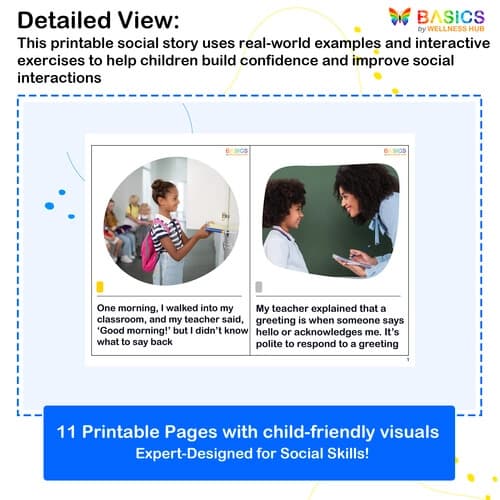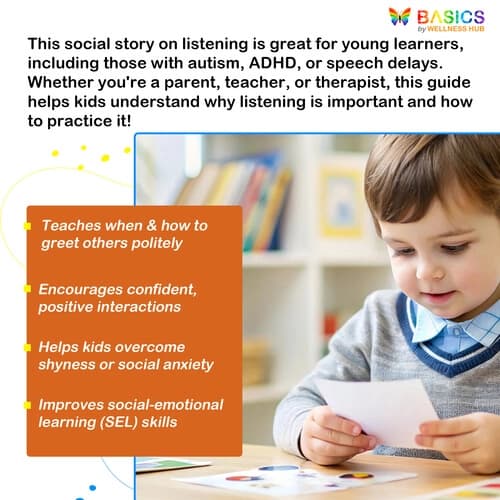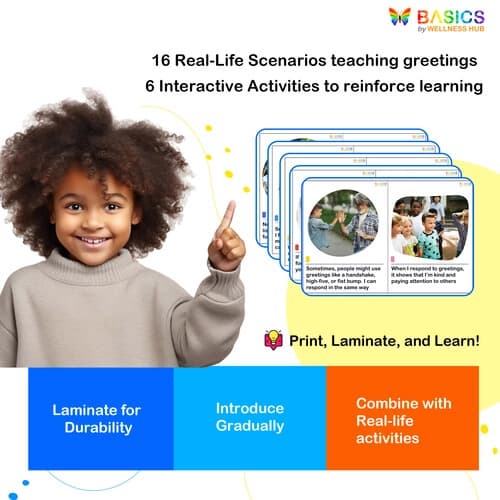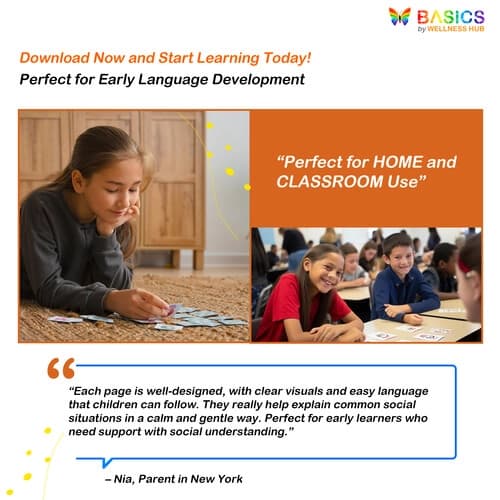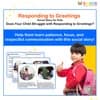

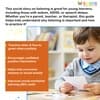

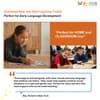
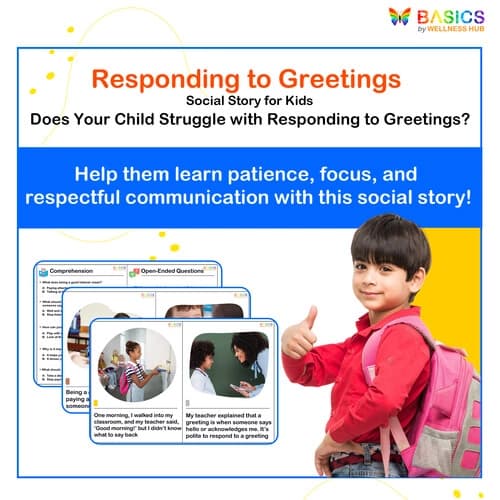
Responding to Greetings – Social Story for Kids
₹80
₹160
50% off
0 (0 ratings)
Grade Levels
Pre-K - Grade 3 (Ages 4-9)
Content Overview
Format: Printable PDF, Total Pages: 11, Features (≤15 words): 16 real-life scenarios, engaging illustrations, interactive activities, kid-friendly language
Categories
Pages from the Resource
Help children learn how to respond to greetings in different social situations with this engaging social story. Through real-life scenarios, illustrations, and interactive activities, kids will practice greeting family, friends, and new people confidently. Perfect for home, classroom, and therapy use, especially for children with autism, ADHD, or social communication challenges.
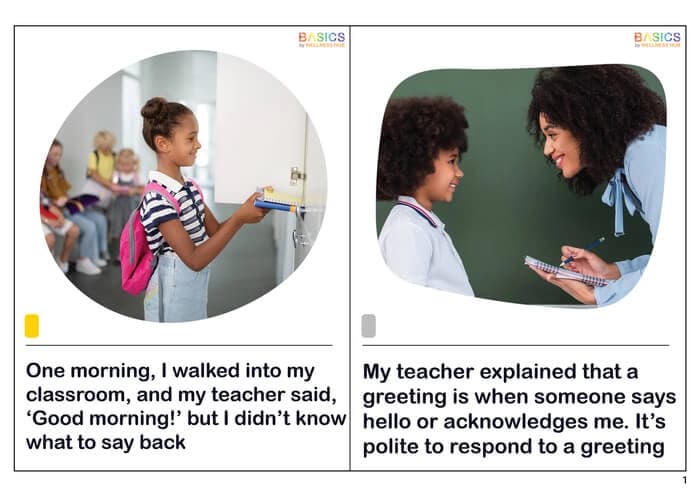
Page 1
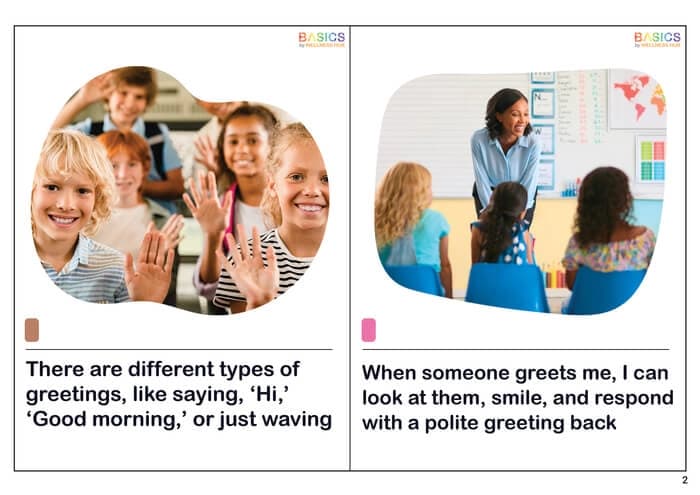
Page 2
What Users Say
0
0 ratings
5
0+
4
0+
3
0+
2
0+
1
0+
5 Stars
Product is Good to use.
1 year ago
Varsha Parent
Similar Products
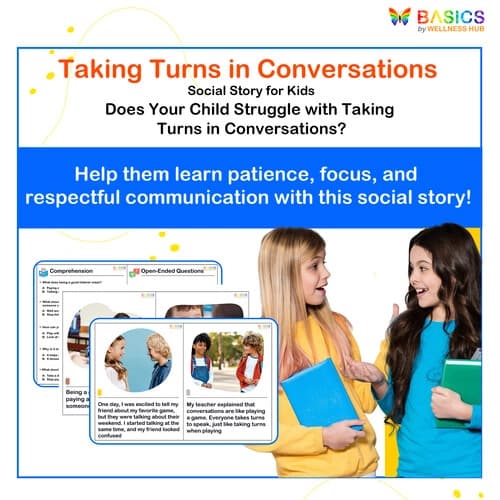
Taking Turns in Conversations – Social Story for Kids
₹ 80.00
₹ 160.00
50% off
4.9 (60 ratings)
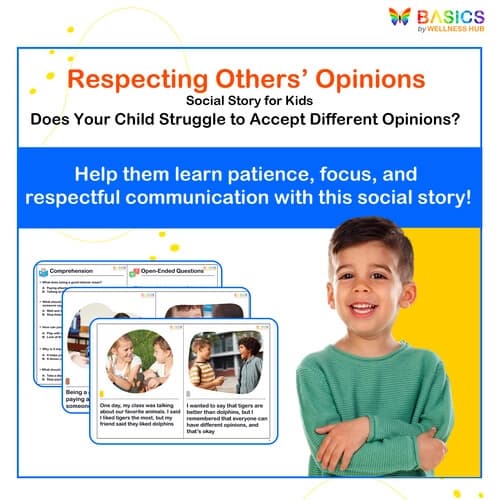
Respecting Others’ Opinions – Free Social Story for Kids
₹ 80.00
₹ 160.00
50% off
4.8 (46 ratings)
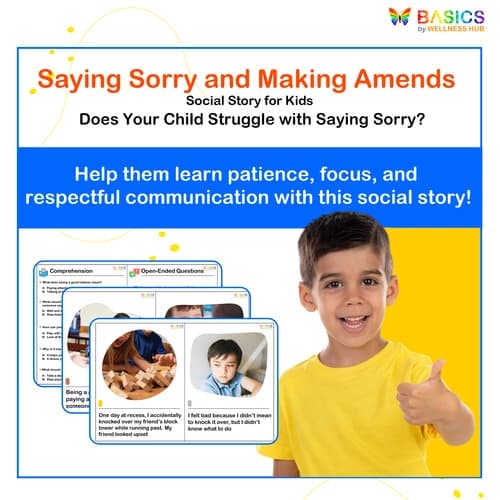
Saying Sorry and Making Amends – Social Story for Kids
₹ 80.00
₹ 160.00
50% off
5.0 (42 ratings)
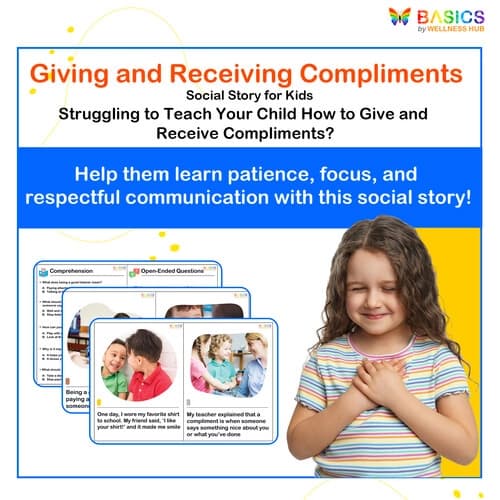
Giving and Receiving Compliments – Social Story for Kids
₹ 80.00
₹ 160.00
50% off
5.0 (52 ratings)

Understanding and Using Polite Words – Social Story for Kids
₹ 80.00
₹ 160.00
50% off
4.9 (48 ratings)
About the Product
Introduction
Greeting others is an essential social skill that helps children build connections, confidence, and communication skills. For some children, particularly those with autism, ADHD, speech delays, or social communication challenges, responding to greetings can be confusing or uncomfortable.
Children may struggle with:
✔ Knowing when and how to say "hello" or "goodbye"
✔ Understanding the social expectations around greetings
✔ Feeling shy or anxious when meeting new people
✔ Using eye contact, tone of voice, or body language appropriately
This printable social story helps children learn why greetings matter and how to respond confidently in everyday situations, such as:
✔ Greeting family members, teachers, and classmates
✔ Responding to friendly hellos from new people
✔ Saying goodbye in different settings
✔ Using polite words like ‘Hello,’ ‘Hi,’ ‘Good morning,’ and ‘Nice to meet you’
By learning how to greet and respond appropriately, children gain social confidence, make friends more easily, and develop better conversational skills.
Product Details
- Format: Printable PDF
- Total Pages: 11
- Number of Segments: 16 real-life scenarios
- Features:
✔ Child-friendly illustrations demonstrating greeting interactions
✔ Clear, simple language for easy understanding
✔ Interactive activities to reinforce learning
✔ Perfect for home, school, and therapy settings
This easy-to-use social story can be printed or used digitally on tablets and computers.
Educational Benefits
1. Builds Social Confidence
- Helps children feel comfortable responding to greetings in various situations.
- Encourages friendly, confident communication in school, home, and community settings.
2. Enhances Social-Emotional Learning (SEL) Skills
- Teaches children how greetings create positive interactions and relationships.
- Encourages empathy and respect by helping kids recognize when and how to return a greeting.
3. Supports Children with Special Needs
- Provides structured, visual learning for children with autism, ADHD, speech delays, or anxiety.
- Reinforces expected social behaviors in a step-by-step manner.
4. Promotes Positive Peer Interactions
- Encourages children to initiate conversations and connect with others.
- Helps kids understand social cues, making friendships and communication easier.
5. Encourages Real-Life Application
- Uses relatable scenarios (e.g., greeting a friend at school, responding to a teacher's hello).
- Reinforces good manners and politeness in natural settings.
Instructions for Use
Step 1: Read the Social Story Together
- Sit with the child and read the story aloud, emphasizing key phrases.
- Discuss each scenario and illustration, ensuring the child understands why greetings are important.
- Ask guiding questions such as:
- “What do you say when someone says hello?”
- “Why is greeting others important?”
Step 2: Engage in Interactive Learning
- Practice role-playing with the child in different greeting scenarios.
- Use the interactive activities included in the resource, such as:
✔ Fill in the blank exercises (e.g., “When my teacher says ____, I say ____.”)
✔ Sorting correct and incorrect greeting responses
Step 3: Encourage Real-Life Practice
- Challenge the child to respond to at least one greeting per day.
- Use gentle reminders when they forget to say hello or goodbye.
- Celebrate their progress with positive reinforcement (e.g., “Great job responding to Grandma’s hello today!”).
Step 4: Revisit & Reinforce
- Read the social story regularly to reinforce learning.
- Encourage caregivers, teachers, and peers to model appropriate greetings.
- Praise and encourage the child whenever they greet others appropriately.
Activities Using the Resource
These interactive activities reinforce the concept of greetings and responses while helping children feel more confident in social interactions.
1. Greeting Match-Up Game (Individual or Group Activity)
Objective: Help children recognize the appropriate greeting for different situations.
Materials: Flashcards with different greetings and situations.
How to Play:
- Prepare flashcards:
- Some with greeting words (e.g., “Hi,” “Good morning,” “Nice to meet you”).
- Some with scenarios (e.g., “At school,” “Meeting a new friend,” “Saying goodbye”).
- The child matches the correct greeting to the situation.
- After matching, have the child practice saying the greeting aloud.
- Discussion: Ask, “Why is this greeting appropriate for this situation?”
2. Role-Playing Everyday Greetings
Objective: Help children practice real-life greeting situations in a safe and supportive setting.
Materials: None.
How to Play:
- Set up different role-play scenarios:
- Meeting a friend at school
- Seeing a neighbor while outside
- Saying goodbye to a teacher at the end of the day
- Take turns playing different roles (e.g., teacher, friend, relative).
- Have the child respond appropriately to each greeting.
- Provide gentle guidance if needed and offer praise for correct responses.
3. Greeting Jar (Daily Practice Activity)
Objective: Encourage children to use greetings in real-life situations.
Materials: Jar, slips of paper, pen.
How to Play:
- Each time the child greets someone correctly, they write it on a slip of paper (e.g., “I said ‘Good morning’ to my teacher”).
- Place the slip into a greeting jar.
- At the end of the week, review all the greetings
- Celebrate the child’s progress with a small reward or praise.
4. Greeting Sorting Game (Good vs. Inappropriate Greetings)
Objective: Teach children which greetings are appropriate in different situations.
Materials: Pre-written greeting cards.
How to Play:
- Write different greetings on cards (e.g., “Hey dude,” “Good evening,” “What’s up?”).
- Have the child sort the greetings into appropriate vs. inappropriate categories based on different scenarios.
- Discuss why certain greetings are better suited for specific situations.
FAQs
Q1: Who is this social story designed for?
A1: This resource is created for children aged 4–9 who need help learning how to respond to greetings appropriately. It’s especially beneficial for children with autism, ADHD, or social communication challenges.
Q2: How often should I use this social story?
A2: Use it regularly (2–3 times per week) to help children become familiar with greetings.
Complement it with interactive activities to reinforce polite social interactions.
Encourage daily real-life practice by prompting children to say hello and goodbye in different settings.
Q3: My child doesn’t like greeting people. How can I help?
A3: ✔ Start with simple, low-pressure greetings (e.g., waving instead of speaking).
✔ Practice in familiar settings with family members before greeting new people.
✔ Use a greeting chart to track progress and offer positive reinforcement.
✔ Model greeting behavior so the child can observe and learn.
Q4: Can this social story help children with social anxiety?
A4: Yes! Many children feel shy or anxious about greetings and social interactions. This story provides structured guidance and visual support, making it easier for children to understand what to do.
Q5: Can I use this in a classroom or therapy setting?
A5: Yes! This social story is perfect for:
✔ Classrooms – Teaching children polite social interactions.
✔ Speech therapy – Helping children with communication delays.
✔ Home use – Encouraging daily practice in real-life situations.
Usage Rights and Restrictions
Allowed Usage:
- Personal use by parents, teachers, and therapists.
- Printable for classroom, home, or therapy settings.
- Can be used in group or one-on-one learning sessions.
Not Allowed:
- Reselling, redistributing, or modifying the resource for commercial use.
- Sharing publicly (e.g., on blogs, social media, or websites) without permission.
- Uploading the file to public sharing platforms.
If you need a bulk license for schools or therapy centers, please contact us.
Conclusion
Teaching children to respond to greetings is an essential social skill that helps them navigate friendships, school, and everyday interactions with confidence. The “Responding to Greetings” social story provides a structured, engaging way to learn polite social behavior through real-life examples, interactive activities, and role-playing exercises.
By consistently using this resource, children will:
✔ Feel more comfortable responding to greetings.
✔ Learn how to engage in polite social interactions.
✔ Develop confidence in their communication skills.
With patience and practice, responding to greetings will become second nature!
